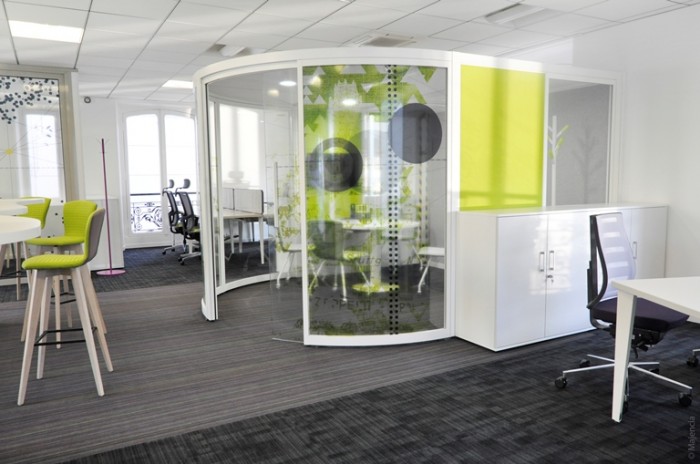How can workplaces meet the needs of ageing employees?
Research shows that challenges faced by older workers are shared by younger colleagues in modern open plan offices
In any debate on how to address the challenges of an ageing population, the design of our places, products and services has a critical role to play to ensure that extended years are full of life rather than extended life being full of years.
Age-appropriate design that helps, rather than unthinking design that hinders and stigmatises, can make a huge difference to quality of life; and this was never more so than in considering access to work and the workplace for older people.
As governments around the world raise the retirement age, we are being asked to work longer. Population ageing is a global phenomenon.
In the workplace, this trend is colliding with under-performing pension funds, which prevent many people from retiring, and, more positively, new legislation introduced to combat age and disability discrimination.
But is the design of the workplace really being tailored to the needs of older people? How can we improve the environment for extended working lives? And why are so many large corporate and government organisations in the UK in particular failing to retain people aged over-55, in a knowledge economy that is supposed to prize expertise?
My research in this field has revealed that while older knowledge workers may well be compromised in the office environment by the inevitable effects of ageing on vision, hearing, posture, memory, balance and dexterity, they tend to compensate cognitively in terms of wisdom, experience and decision making. They are also, contrary to popular myth, flexible learners – they have adapted to several waves of business and technological change over lengthy careers.
When I led an in-depth study (Welcoming Workplace, pdf) of office workers aged over-50 in three knowledge-intensive industries – pharmaceuticals, technology and financial services – a clear picture emerged. The RCA collaborated with academic partners in Japan and Australia to engage an international group of senior workers – research chemists, process engineers and financial analysts – whose early departure from their organisations would leave a hole in the knowledge base.
What we learned was that this demographic group did not wish to draw attention to itself through the provision of special needs design for older workers. The challenges they faced in the workplace – noise, distraction, frustrating IT systems, general discomfort and a dispiriting lack of wellbeing – were precisely those shared by people of all ages working in large, modern, open plan offices.
We therefore identified an inclusive design approach as a way forward, promoting the multi-generational idea of a better workplace for all ages and abilities. We focused on the three main activities seen as most important in terms of design – concentration, collaboration and contemplation – and developed experimental settings to test interventions in user-controlled lighting, ergonomic furniture, natural soundscapes and other humanising features.
We discovered that young workforces have far more in common with their greybeard colleagues when it comes to the physical workspace than is commonly believed. It isn’t just older workers who crave quiet and privacy when they want to concentrate on solo tasks – or dedicated tools and spaces for collaboration when they want to work in a team. Everybody does.
We advocated concentration spaces that are governed by strict protocols for working (for example, no mobile phone calls or loud conversations, as in a library). These spaces should be located away from noisy facilities such as kitchens and cafés, print-rooms or social spaces. They should be equipped with different types of furniture and adjustable settings to allow for a range of working positions, as poor ergonomics and uncomfortable posture will adversely affect the ability to get into “flow”.
Natural light should beused in concentration spaces wherever possible, with fabric curtains and blinds to diffuse light. Task lights at the desk are an important consideration for ageing eyes and for reading printouts off-screen, and a lower and more pleasant level of general ambient lighting within the concentration space. We also suggested the use of sound-masking systems that can reduce distracting noise.
Our research indicated that dedicated collaboration space within the work environment should be provided so older people who have honed their skills in the pre-digital era can spread out sheets and data, and not worry about confidentiality or tidying away before the project is completed. This type of space should be able to be reserved by the day, week or month, and there should be a mix of digital and traditional display media. Bigger desks to spread things out and bigger backdrops to pin things up will enhance collaborative modes of working for older people.
Finally, all generations get sick and tired of work at certain times and would like somewhere to go to recuperate briefly from the stress and noise of the normal work environment.
The provision of contemplation space that can provide a calm environment free from distraction and surveillance is important to making ageing workforces more productive – and evidence suggests it would be popular with everyone. Here we advocated strong natural and organic elements, rich with plants, water, fabric banners and adjustable lighting, giving a different feel to the office atmosphere elsewhere.
However, contemplation remains the missing link in office design, particularly so in the aftermath of the financial crash, which has depleted workplace design budgets. It seems we still have a long way to go to make our workplaces more welcoming and comfortable. Right across the age range.
Jeremy Myerson is director and chair of the Helen Hamlyn Centre for Design at the Royal College of Art, London, and the co-author of New Demographics New Workspace (Gower 2010)







